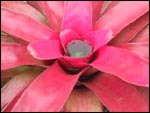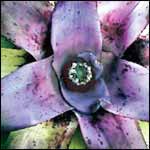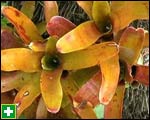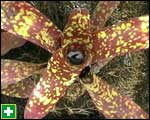Caring
for bromeliads
Bromeliads indoors,
bromeliads in trees, bromeliads in the garden — your guide
to growing these stunning plants.
 Many people are surprised
to learn that pineapples are bromeliads and, although pineapples
are attractive, we all know that they are cultivated for their good
taste, not their good looks. Many people are surprised
to learn that pineapples are bromeliads and, although pineapples
are attractive, we all know that they are cultivated for their good
taste, not their good looks.
Fortunately, there are
plenty of other ornamental bromeliads that are decorative in the
garden: in total more than a thousand species. Some of the most
popular are the Neoregelias, with their colourful central bracts,
the Guzmanias with stunning flowers, the nodding Billbergias, and
the curious old man's beard or Spanish moss (Tillandsia usneoides)
that hangs in festoons from trees.
Where will bromeliads
grow?
 Bromeliads are happiest in
frost-free gardens in the light shade of trees. In cold areas most
species can successfully be grown in well-lit spots indoors. Bromeliads are happiest in
frost-free gardens in the light shade of trees. In cold areas most
species can successfully be grown in well-lit spots indoors.
Growing bromeliads
indoors
Choose a bright position that's not too far from a window.
Keep the plants away from draughts and make sure there's plenty
of moisture around them. This means spraying regularly with a light
mist and keeping central wells topped up with water.
Growing bromeliads
in trees
Many bromeliads are epiphytic, which means they grow naturally
up in trees. In warmer climates they can be grown this way in the
garden to create very striking effects. However, it may be better
for the tree if bromeliad plants are attached to some sort of backing
board rather than to the tree itself.  Try making an artificial bromeliad
support 'log' by forming a cylinder from mesh and packing it with
sphagnum moss or bark. Try making an artificial bromeliad
support 'log' by forming a cylinder from mesh and packing it with
sphagnum moss or bark.
Growing bromeliads
in pots
Because bromeliads have relatively small root systems,
they prefer being crowded in containers. Use a well-drained potting
mix (Yates Orchid Mix is ideal) and feed gently with some Nutricote
controlled release pellets.
Growing bromeliads
in the garden
Bromeliads can be grown in garden beds, but to achieve
success it's important to take all of their needs into consideration.
Light shade, extra-good drainage, a moist atmosphere and warmth
are all important.
Fertilising
bromeliads
 The easiest way to feed 'broms' is
with a liquid orchid fertiliser. Yates Thrive Concentrate Orchid
Food can be diluted with water and applied regularly during the
plants' growing season. The easiest way to feed 'broms' is
with a liquid orchid fertiliser. Yates Thrive Concentrate Orchid
Food can be diluted with water and applied regularly during the
plants' growing season.
Dividing bromeliads
After flowering, most bromeliads produce pups. The central
'mother' part of the plant dies and smaller plants (commonly called
pups) grow around it. Pups can be removed and replanted when they
are about one third the size of their mother.
Reproduced
with permission from NZOOM Home and Garden content,
from the previous
website of 
The views expressed here are not necessarily those of the RNZIH
 |
|
HOME
AND GARDEN |
|
|
More
Garden Articles
|